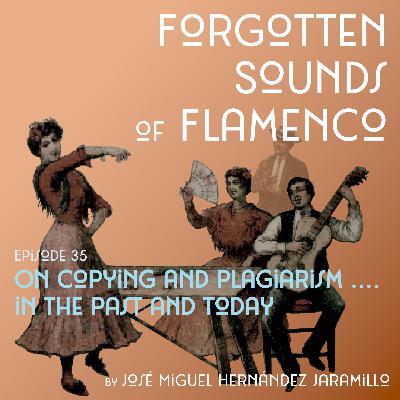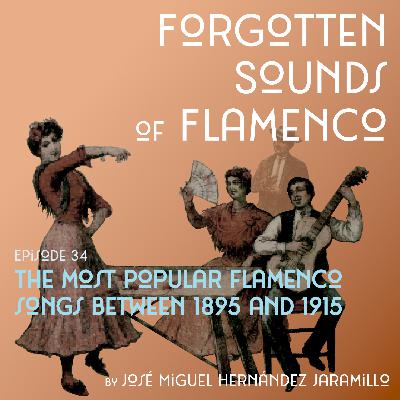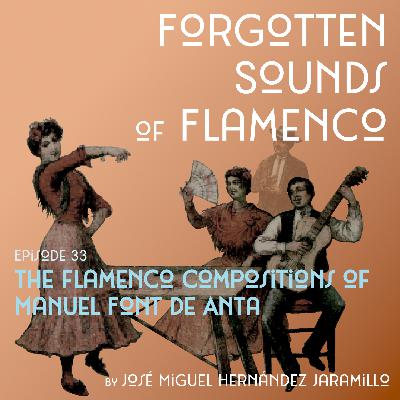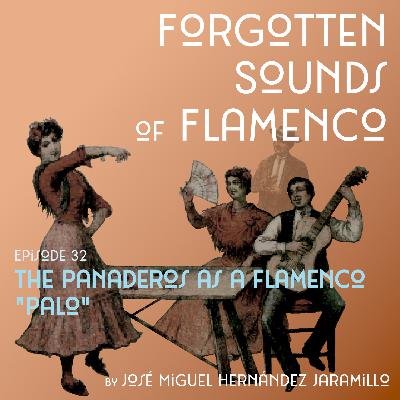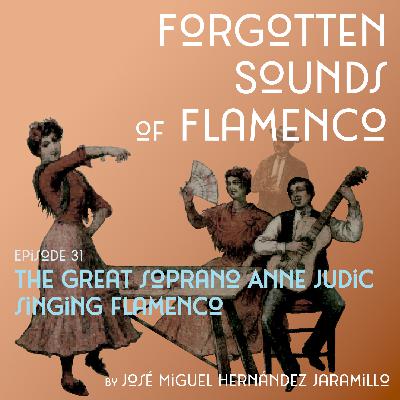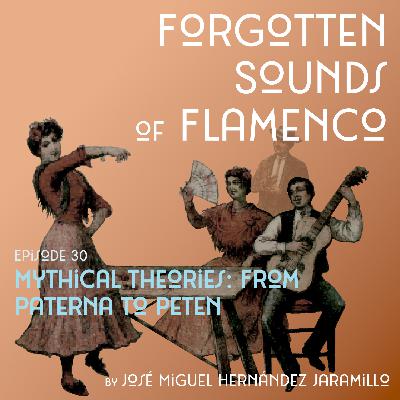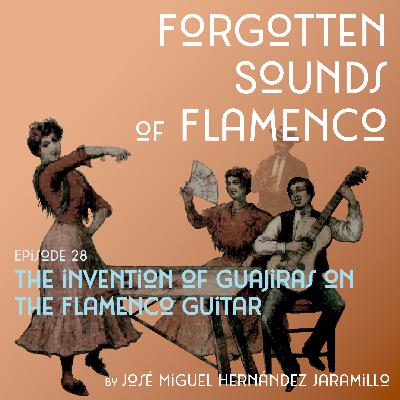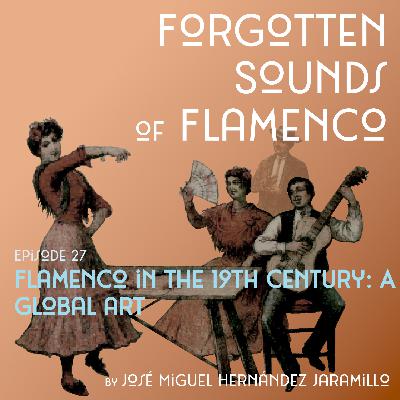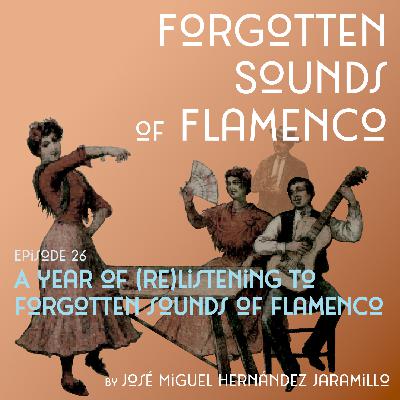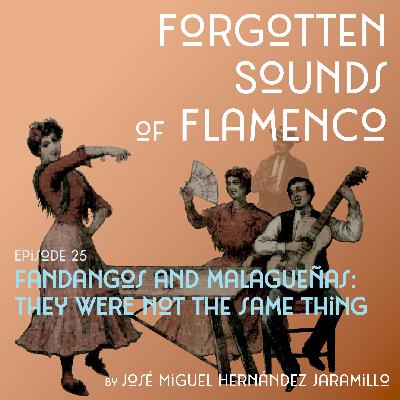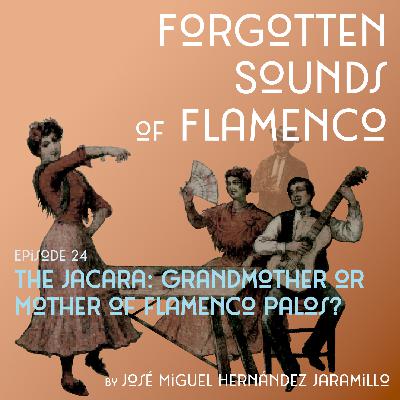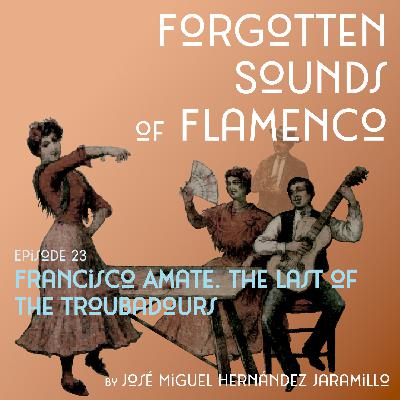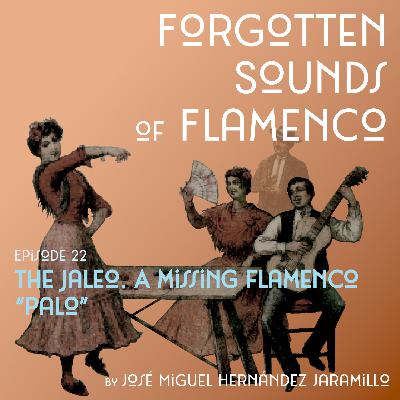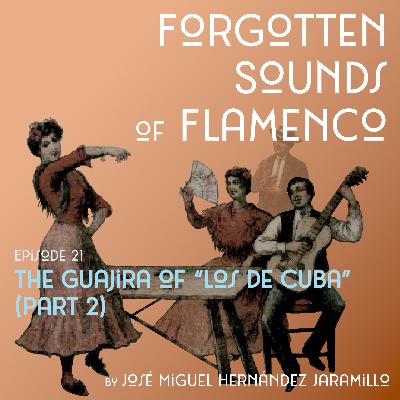Discover Forgotten Sounds of Flamenco
Forgotten Sounds of Flamenco

Forgotten Sounds of Flamenco
Author: José Miguel Hernández Jaramillo
Subscribed: 4Played: 64Subscribe
Share
© José Miguel Hernández Jaramillo
Description
The podcast "Forgotten Sounds of Flamenco" proposes a journey to the world of sounds, stories, spaces and characters that were part of the early stages of flamenco, and that in many cases today are forgotten about the histories of music and flamenco. It is conducted by the ethnomusicologist José Miguel Hernández Jaramillo, with the aim of sharing some of the results of his research work in this matter with all people passionate about history, culture, music and flamenco.
41 Episodes
Reverse
In the world of flamenco research, sometimes we resort to what we call "cajones de sastre," which are sentences that serve to conclude the research on a specific topic instead of investigating it further. In this episode, we review some of the most commonly used "catch-all drawers" and listen to some very unknown 19th-century flamenco music.
As a result of the arrival of the guajira to Spain from Cuban lands, and due to the rapid popularity it had throughout the country, new models of guajiras began to emerge, and some of them were very popular, among them the so-called "Guajiras vida mía," which were all the rage at the beginning of the last century. In this episode, we discuss what these guajiras were like and if they had any precedent in Cuba. You can listen to some musical samples of this type of guajiras.
The "Alegrías de Cádiz" is nowadays one of the most famous flamenco songs, dances, and guitar playing in flamenco recitals and concerts, but did you know how long this palo has been known by that name? In this episode, we talk about the early days of alegrías, and we listen to some musical samples of old alegrías and music that may have been related to them.
One of the intriguing puzzles in flamenco history is the sudden appearance of the soleá in the mid-nineteenth century. A decade and a half ago, Lénica Reyes and José Miguel Hernández Jaramillo conducted research that unearthed enough clues to propose a hypothesis about the formation of the soleá. The results, which were unveiled at a conference in 2010, are yet to be published. In this episode, we delve into these groundbreaking findings that highlight the direct correlation between the soleá and a song that was imported from Mexican lands: The petenera.
In the world of flamencology, some theories about the beginnings of the flamenco concert guitar contrast with recent research. In this episode, we analyze what these differences consist of, and we will see if we can really consider that there was a flamenco concert guitar in the 19th century, listening to some musical samples from that period.
There have always been people who have taken ideas and music from others without mentioning them, claiming authorship, or even making money out of it. In this episode, we show how this questionable practice has existed since the early days of flamenco, both in writing and in flamenco music itself. We hear some musical examples that clearly illustrate it. We also talk about how this practice, unfortunately, still exists.
Hit lists are a great way to get an insight into the most popular songs of a specific time frame. For this episode, we have curated a definitive list of the best flamenco hits, considering the recordings produced in the first two decades of the recording industry. We will thoroughly inspect the top ten highest-ranked flamenco songs (palos) on this remarkable list.
The Sevillian composer Manuel Font de Anta is perhaps best known for authoring some of the most emblematic processional marches of Holy Week, such as "Amarguras" or "Soleá dame la mano." What is not so well known is that Font de Anta also composed some flamenco works for piano. In this episode, we review some of these works, which are entirely unknown, and listen to some of them.
The name "the panaderos" was given to popular music and dance in Spain in the 19th century. They probably arrived to Spain from Mexico, where it was already being danced two and a half centuries ago. It was a common "palo" in the flamenco of the 19th century and somehow, as we see in this episode, never disappeared. We review the history of the panaderos in flamenco and listen to some of them from the 19th century, some of which still need to be discovered.
At the end of the 19th century, one of the most important European singers of the time, the French Anne Judic, triumphed in Spain, Mexico, and Cuba, singing one of the most famous flamenco songs of the time: the peteneras. In this episode, we review who Anne Judic was, how she arrived in Spain, where she learned to sing the peteneras, and why she drove half the world crazy with her voice. We also hear her own voice singing on an old wax cylinder and some of the flamenco compositions inspired by Anne herself.
The history of flamenco has been built through various theories. Some of them we call "mythical theories," which are those that, although they were formulated with arguments of dubious rigor, everyone has ended up accepting them as accurate over time. In this episode, we describe what we mean by "mythical theories," and we describe a couple of examples that refer to the same stick: the petenera.
At the end of the 19th century, a priest, the organist of the Cathedral of Seville, composed some of the most beautiful flamenco pieces for piano of his time. In this episode, we review the flamenco works of Buenaventura Íñiguez, a Navarrese who lived the last 37 years in Seville. We also listen to a good part of his flamenco compositions, some very virtuosic.
In this episode we talk about how flamenco guitarists had to create new toques throughout the 19th and early 20th centuries as new cantes were integrated into flamenco. For example, it is illustrated with the guajira guitar playing and some of its most characteristic falsetas, which were not created out of thin air and are perhaps based on music from countries thousands of miles away from Spain.
From its beginnings in the 19th century, flamenco has had a significant international impact. Flamenco artists toured half the world with their art, and foreigners composed many flamenco musical pieces in the 19th century. In this episode, we see some stories showing intense flamenco activity, especially in American and European countries. We also hear flamenco music composed by French composer Gabrielle Ferrari.
After the first year of this project is the podcast "Forgotten Sounds of Flamenco", in this last episode of the season, we review how the first 25 episodes have gone, what reception it is having in many countries around the world, and we remember some of the characters, stories and sounds that have been the protagonists of this season. We also talk about the beautiful music that serves as the tune of the podcast.
In flamenco, it is said that the malagueña belongs to the fandango family or is a cante derived from it. Some authors even claim that the malagueña and the fandango were mainly the same in the 19th century. In this episode, we review the analysis that Lénica Reyes made of both cantes in the 19th century to see how they were similar and differed. You can also listen to music from both cantes you have never heard.
In flamenco, it is common to establish phylogenetic relationships between the different palos, as if each had necessarily derived from a previous one. One widespread theory is that the 17th-century jácara is the mother or grandmother of many palos. In this episode, we comment on what the theories supporting this kinship have been based on and analyze them to see to what extent they can be considered correct or questionable.
This episode is extraordinary because of the importance of its protagonist in the history of flamenco: Don Francisco Amate. An amateur flamenco singer who, as fate would have it, recorded some non-commercial wax cylinders in Los Angeles (USA) at the beginning of the 20th century. These recordings are one of the few samples of how flamenco was sung before commercial recordings appeared.
Throughout the history of flamenco, some palos have been incorporated into it, and others fell into disuse until they were practically forgotten today, such as the jaleo, not the jaleos extremeños, but the jaleo. In this episode, you can hear how the jaleo sounded, both in the concert flamenco guitar and in the very few recordings made of the jaleo; some of them never sold commercially.
This episode continues the previous one and is dedicated to the history of a guajira that is still sung in flamenco and has at least 135 years of history. This guajira was part of the zarzuela "Los de Cuba" from 1888. In this episode, we see how, due to its popularity, flamenco artists began to sing and record it at the beginning of the 20th century. Even today, we can still hear it in the mouths of some flamenco singers and singers.



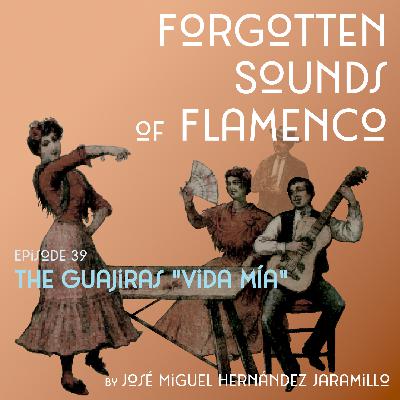
![38. The early days of Alegrías [PODCAST Forgotten Sounds of Flamenco] 38. The early days of Alegrías [PODCAST Forgotten Sounds of Flamenco]](https://s3.castbox.fm/74/f1/54/478646378ff8578ec50e7525b263fee598_scaled_v1_400.jpg)


